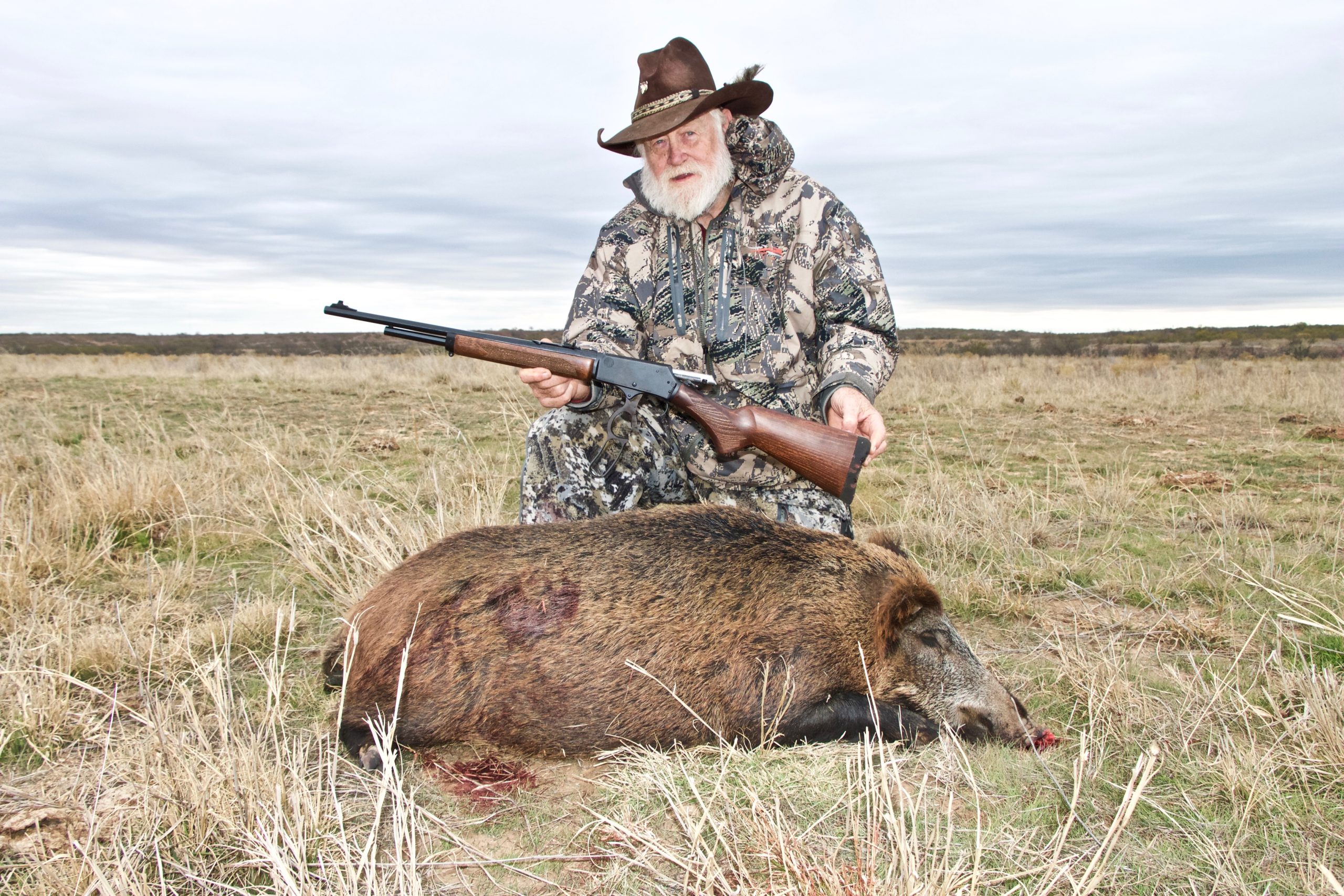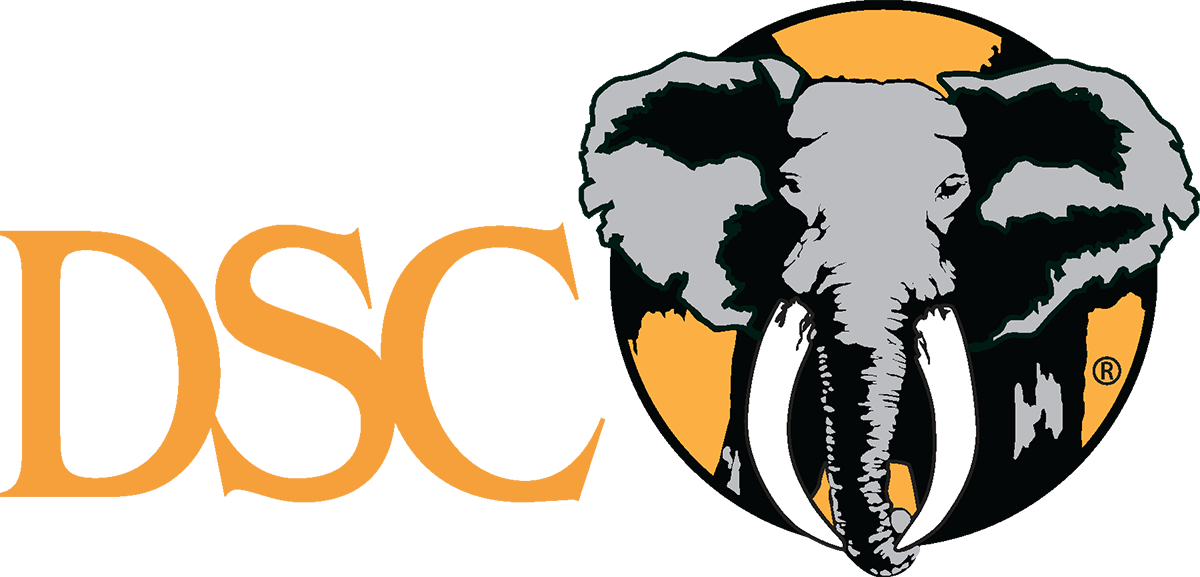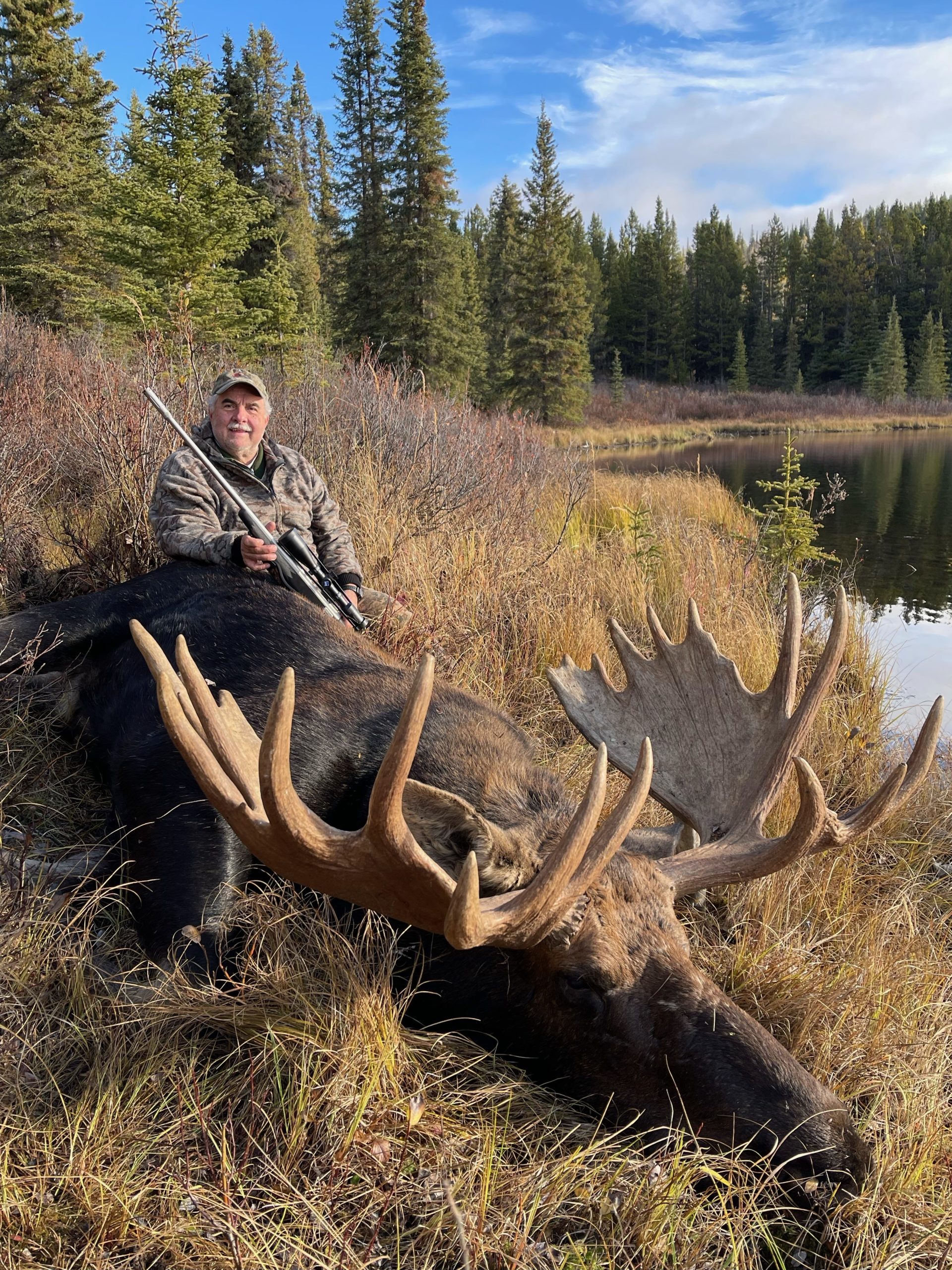Rethinking Arrow and Broadhead Performance
A NEW Series of Bowhunting Articles by the Ashby Bowhunting Foundation
Article 4: Factor 3 – Arrow Weight Forward of Center (FOC)
Would you like to hunt with arrows and broadheads that give you pass-throughs on big game shot after shot? Would you like to have complete confidence in your arrows and broadheads to give you lethal penetration and reliable kills even if you hit bone? Of course, you would! Every serious bowhunter wants that kind of performance from their setup. Join us for Dr. Ed Ashby’s Top 12 Penetration Enhancement Factors.
 After extensive testing, Dr. Ed Ashby identified twelve specific arrow penetration enhancement factors. He then ranked them in order of importance so that bowhunters would have a straightforward guide as to what they should build into their arrow and broadhead setups—and in what order—so they could create the most reliable and lethal setups possible.
After extensive testing, Dr. Ed Ashby identified twelve specific arrow penetration enhancement factors. He then ranked them in order of importance so that bowhunters would have a straightforward guide as to what they should build into their arrow and broadhead setups—and in what order—so they could create the most reliable and lethal setups possible.
To optimize your arrow and broadhead builds, it is recommended that you incorporate as many of the 12 Penetration Enhancement Factors as possible. The third factor, Arrow FOC, will be discussed today and marks the start of the factors that involve a bit more evaluation. Plus., there will be a thorough recap and review at the end of the article to refer back to.
“Using arrows having Extreme or Ultra-Extreme FOC (EFOC and Ultra-EFOC) does more than any other feature except flight-quality to maximize the effect other factors offer.” Dr. Ed Ashby
Arrow Weight Forward of Center, or FOC as it is commonly referred to, is a standardized measure of the location of an arrow’s balance point in reference to its physical center. Unlike the previous factors, which essentially boil down to a pass/fail, FOC is a sliding scale that can help you understand quite a lot about how your arrow system will dynamically function. With FOC, there really is no clear cut ‘pass-or-fail’, but once you understand what you’re looking for when you increase your arrow’s FOC, you will see that as the percentage of FOC increases, there are many benefits.
Before we dive too far into what it can tell us and how it’s beneficial though, let’s breakdown exactly what it is, and how it’s calculated. For those of you who prefer to calculate things the old way with a calculator, this is for you (and for those who prefer the easy button, there are plenty of calculators online that you can enter your data and they will show your calculated percentage).
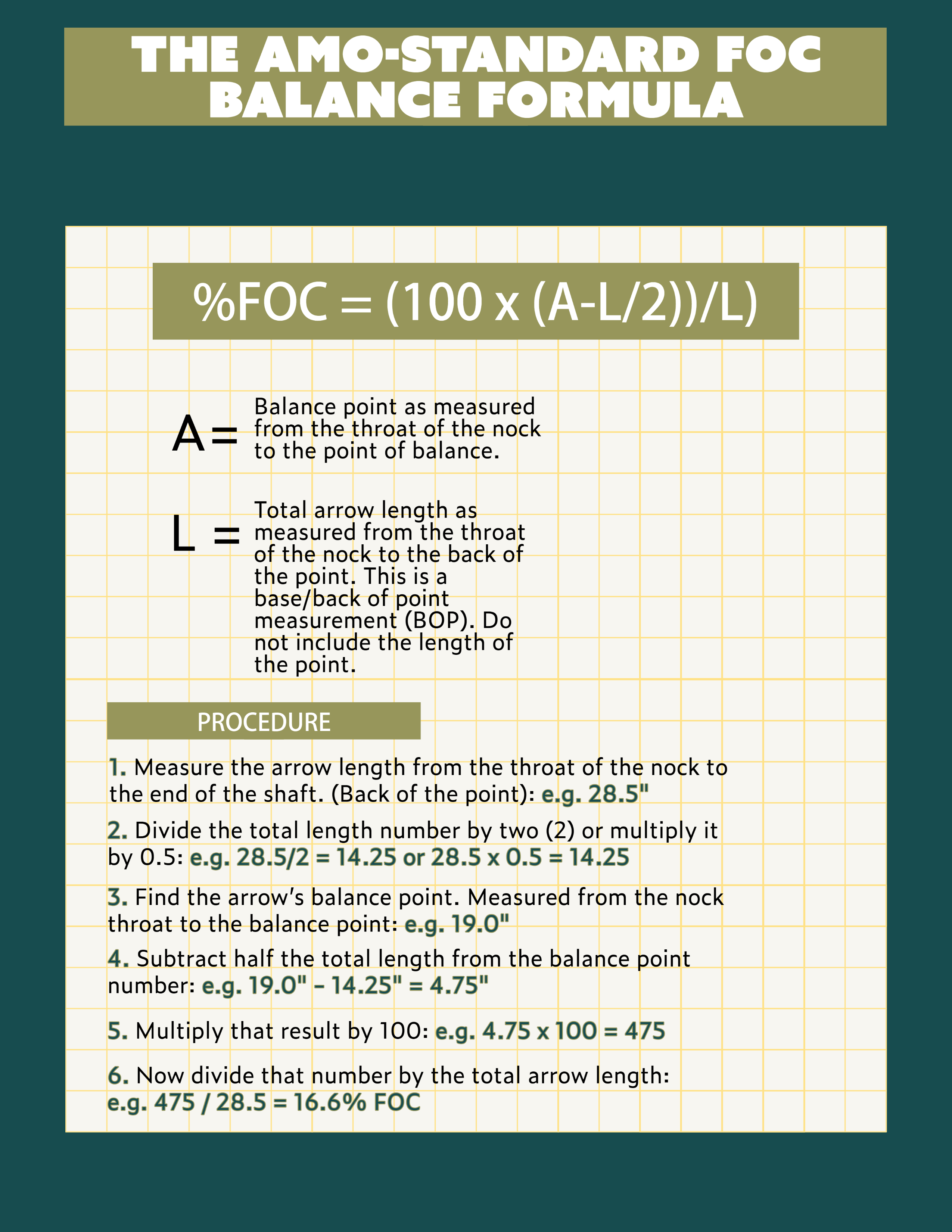
Go grab one of your current arrows and play along as we break this down.
Formula:
The AMO-Standard FOC balance formula is as follows: %FOC = (100 x (A–L/2))/L)
A = Balance point as measured from the throat of the nock to the point of balance.
L = Total arrow length as measured from the throat of the nock to the back of the point. This is a base/back of point measurement (BOP). Do not include the length of the point.
Procedure:
- Measure the arrow length from the throat of the nock to the end of the shaft. (Back of the point): e.g. 28.5″
- Divide the total length number by two (2) or multiply it by 0.5: e.g. 28.5/2 = 14.25 or 28.5 x 0.5 = 14.25
- Find the arrow’s balance point. Measured from the nock throat to the balance point: e.g. 19.0″
- Subtract half the total length from the balance point number: e.g. 19.0″ – 14.25″ = 4.75″
- Multiply that result by 100: e.g. 4.75 x 100 = 475
- Now divide that number by the total arrow length: e.g. 475 / 28.5 = 16.6% FOC
Example:
A 28.50” (BOP) arrow has a balance point of 19.00”.
Half of the total arrow length is 14.25.
Subtract 14.25 from the 19″ and you get 4.75″.
Multiply that by 100 = 475.
Now divide 475 by the total length which is 28.5 = 16.6.
Your percent FOC is 16.6%
Now that we all know how to calculate our FOC and hopefully have determined the FOC of our current setup, let’s break down what it means for us as bowhunters.
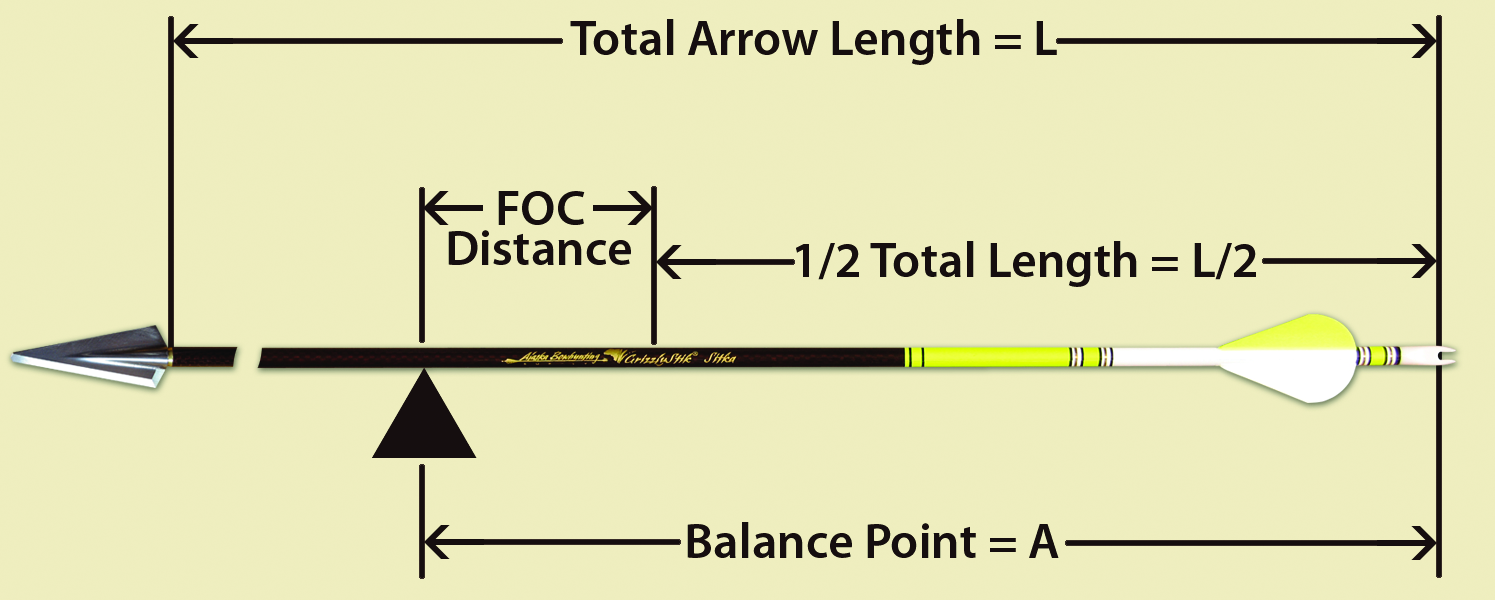
The first aspect that needs to be understood is that the position of the balance point helps us understand how a shaft acts dynamically. While in motion, the arrow will tend to move around the balance point. To visualize this, hold your arrow in between two fingers at the balance point and tip it back and forth and side to side. Change your holding position further forward and backward to see how the amount of movement at the ends of the shaft changes. In a very rough way, this is how the shaft is moving when it is trying to stabilize in motion and it gives us two distinct sections of shaft that can affect the rest of the shaft in various ways depending on its overall length.
The best way to look at these two sections is as simple levers. Forces are being applied to both ends, acting on those levers, which pivot at the balance point and are then trying to cause the rest of the shaft to move. At the end of the front lever is the broadhead. At the end of the rear lever is the fletching. Both are essentially wings applying pressure against the shaft that if given the chance will try to take control and direct the flight path. It’s just like when you are trying to break a stuck bolt loose, the longer your wrench is, the more leverage you have, and the more power you have. The longer your lever arm is the more power you are exerting, so the easier it is to get something to move. What we are talking about with the lever arms on an arrow is no different.
As you may have already guessed, Flight Quality (Factor #2), can be directly impacted by the level of FOC your shaft has. The level of FOC dictates how much control both your fletching and the broadhead have, and we all know what happens when a broadhead steers. At a minimum, we need enough FOC to provide a long enough lever for the fletching to have more control than the broadhead. The minimum level needed can depend on the surface area and overall drag of both ends, but regardless, giving more leverage to the fletching and less to the broadhead is beneficial. Not only does higher FOC give the fletching more control over the flight of the arrow, but the shorter front lever arm means that the broadhead’s influence on the flight of the arrow will be minimized. The longer lever arm of the fletched end of the arrow increases the stabilization power of your fletching. The more stable the mass at the front of the shaft stays, the more consistent the point of impact will be down range. With broadheads this is critical, but it applies to field points as well.
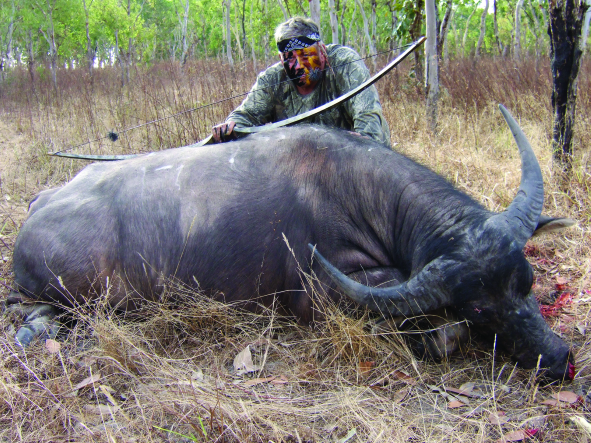
A perfect example of this occurred recently in the competitive archery world where Tim Gillingham set a potential new world record(s) while shooting in the Compound Master Men Outdoor National Championship in Richmond, Virginia. When asked about it by Competition Archery Media after the match, he mentioned that he had recently altered his arrow build and noticed some immediate improvements in overall consistency and accuracy: shooting a 711 in his first practice round with the new build. When asked about the changes, Tim said in a quote from Competition Archery Media Interview 8/19/21, “I bought some points. Some real heavy break off points, 175gr points and more, just to deal with the wind. Little arrows are really sensitive sometimes, and I thought maybe if I load the points up on these little arrows it will make them a little more forgiving.” By the end of the competition, Tim had claimed 3 unofficial new world records including a 72-arrow record of 710 points, a 36-arrow record of 355 points, and a 144-arrow record of 1413 points.
The reason increasing the point weight means the arrows are more forgiving is due to how the higher FOC percentage helps keep the centralized mass at the front of the shaft stable in flight. The less all that mass moves around, the less the shaft will drift off the intended flight path, and the more consistent the point of impact will be down range. For most folks running standard factory fletched Blazer vanes and a typical 1.125 to 1.25-inch-wide fixed blade this forgiveness and additional consistency can start to be seen around 15 percent. The big thing to remember is that your shaft needs to be stiff enough to properly handle whatever weight you add to the front of the shaft. A shaft with a weak reaction will have an opposite effect as too much flex will be occurring in general, leading to less consistency, especially with broadheads.
[box type=”info”] Important Note! At this point, we want to make something completely clear. One cannot just take a given arrow shaft with a given spine-stiffness and just keep adding heavier and heavier points in order to achieve higher and higher amounts of FOC and expect to see perfect flight the entire time –because higher weight points weaken the shaft’s dynamic spine and will alter the quality of the flight of the arrow. To gain the many benefits offered by Extreme and Ultra-Extreme FOC one must maintain perfect arrow flight. The ‘spine’ of the arrow must be stiff enough to fly perfectly with the points used to increase the FOC percentage. When first working on a build – you may need to start with a few various arrow spines and do the testing until you find a combination that works well for you. [/box]
Now, everything just mentioned is great, but we already know that flight quality and accuracy are important. What makes FOC stand out enough to be listed as the third most important penetration factor though?
Those same lever arms discussed for flight still apply at impact. Grab your arrow again and try to flex the shaft holding both ends. Pretty easy, right? Ok, now move one hand to the middle of the shaft and try to flex it again. It feels quite a bit stiffer, doesn’t it? The shaft itself didn’t change, so what did? The thing that changed is the leverage you could apply using the shaft itself. The longer the shaft, the easier it can flex. The shorter the shaft, the harder it will be to flex.
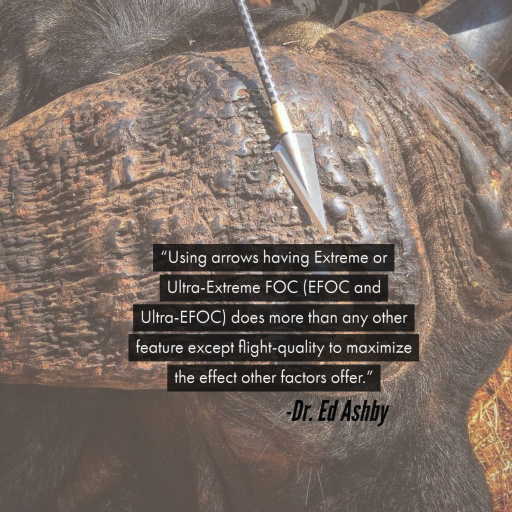
Just like how the shaft moves around the balance point in flight, it will flex around the balance point when under pressure. As the FOC increases, the front lever will be getting shorter resulting in a stiffer reaction at impact. The less the front of the shaft flexes at impact, the less drag, resulting in less wasted energy, and will show an increase of straight-line penetration. The reduced flex also means less chance of skipping or the broadhead penetrating at an odd angle and redirecting the path of penetration. As has been noted before, efficient use of force is everything when it comes to penetration, and this is no different. The higher the level of FOC you achieve, combined with the stiffer the reaction at impact, the greater the penetration potential will be.
The first significant increase that Dr. Ed Ashby noticed in his testing was when arrows reached 19 percent FOC. Arrows above this threshold were described as having Extreme Front of Center (EFOC) to indicate the change in overall penetration potential. Before this, only “normal FOC” (under 12 percent) and “high FOC” (above 12 percent) were typically described. When EFOC was incorporated with the other penetration factors, testing showed upwards of a 40 percent gain in tissue penetration over equal arrows below this threshold (same overall drag, broadhead, total weight, etc).
That’s a huge improvement! It is also worth noting that, while increased FOC arrows did not tend to increase the likelihood of a heavy bone breach (more on this in a later article), the increased tissue penetration post heavy bone breach was quite substantial. Again, the reduced flex of the shaft at impact and during initial penetration lends itself to drag less through the broken bone. The more flexible rear end of the shaft has time to recover and can be imagined as being pulled along for the ride.
The increased frontal stiffness also has another benefit that most do not account for–Durability. Think back to the first factor we discussed. One of the considerations for Structural Integrity was the amount of support the components provided to the shaft. This support reduces load on the carbon as it tries to flex at impact. The key word there is “flex.” The higher the FOC, the less flex at impact, the less stress on the carbon and the component resulting in a system that can handle these types of impacts with a much lower risk of damage.
To wrap things up, let’s recap a little.
Levels of FOC:
- Normal FOC
- Less than 12%
- High FOC
- 12%-18%
- Extreme FOC
- 19%-30%
- Ultra-Extreme FOC
- Above 30%
Increased levels of FOC help improve the following:
- The arrows overall structural integrity at impact (Improving Factor #1)
- As FOC increases so does the stiffness at impact and thus the overall structural integrity
- The arrows stability in flight (Improving Factor #2)
- Over 15% FOC tends to make fixed broadheads more forgiving
- Overall tissue penetration potential
- Over 19% FOC shows upward of 40% gain
Please note that all FOC testing was done with all other factors equal. What has been described is accurate whether the arrow is 400gr or 1000gr and both can achieve beneficial levels of FOC. As was noted early in the article, unlike the first two factors this is not necessarily a pass/fail type of evaluation. Looking at the system as a whole, increased FOC can naturally occur simply by focusing on increased durability. Strong broadheads and components tend to weigh more than their average counterparts. While you may not be maximizing the overall potential, there is no denying that simply utilizing a longer 100gr stainless component paired with a solid 125gr or heavier broadhead will simultaneously improve your overall durability as well as your FOC.
On the flip side, you do not want to purely focus on FOC either. It does no good to sacrifice durability by using an extremely light weight shaft that is more brittle or to sacrifice flight quality by using a weaker spined shaft because it is lower in weight. Focus on making the improvements that make sense for your intended purpose and use the information on all of the factors to understand where your final build needs to land so that you can use it as effectively as possible for all your bowhunting.
Get to know the authors!
[author] [author_image timthumb=’on’]https://www.biggame.org/wp-content/uploads/2021/06/dr-ed-ashby-bio-pic-002.jpg[/author_image] [author_info]Dr. Ed Ashby
Dr. Ed Ashby, a legend in the archery hunting community, dedicated more than 27 years to the study of arrow performance and broadhead lethality. His involvement in the historic Natal Study helped validate just how lethal archery equipment could be on all sized big game animals and was the main reason that bowhunting was ever legalized in South Africa. [/author_info] [/author]
[author] [author_image timthumb=’on’]https://www.biggame.org/wp-content/uploads/2021/06/rob-hummel-bio-pic-002.jpg[/author_image] [author_info] Rob Hummel
With a background in fabrication and engineering, the current standard being pushed by the industry didn’t feel right when Rob first entered the world of archery. Fortunately, after being directed to some of the reports from Dr. Ed Ashby’s field research it all began to align with the mechanics he already understood. Over the last decade, Rob has continued pushing to bring consistent lethality to the forefront of the archery industry. [/author_info] [/author]
[author] [author_image timthumb=’on’]https://www.biggame.org/wp-content/uploads/2021/06/todd-michael-smith-bio-pic-002.jpg[/author_image] [author_info] Todd Smith
For over 40-years, his passion for bowhunting and thirst for knowledge and understanding have driven Todd to learn everything he could about arrows, broadheads, and arrow lethality. Todd is an author, public speaker, and has helped to educate tens of thousands of bowhunters on how to set themselves up for bowhunting successes by using proven – lethal – arrow and broadhead set-ups.[/author_info] [/author]

[box] What’s the Ashby Bowhunting Foundation all about?
The Ashby Bowhunting Foundation is dedicated to continuing Dr. Ed Ashby’s research and to ensuring that bowhunters everywhere will have free access to information that will help them build extremely lethal and reliable arrow and broadhead setups for all species of big game. The foundation was started in 2017 to continue the work of Dr. Ed Ashby that has benefited bowhunters worldwide for decades. The Foundation’s goal is to provide information to achieve the highest possible success rate and reduce the wound/non-recovery rate of big game to the lowest level possible. Through a program of continuing research, the Foundation seeks to find the most lethal arrow setups, taking into account all possible hits under real hunting conditions, controlled testing and using freshly culled animals. The results of this testing is always made available to the global bowhunting community free of cost, utilizing multi-media outlets for information and test results. The Ashby Bowhunting Foundation is excited for this opportunity to partner with DSC and to share these articles with all DSC members so they can make informed decisions of whether to change to arrow and broadhead combinations that will increase their odds of bowhunting success under all situations and conditions. For more information please visit: https://www.biggame.org/ashby-bowhunting-foundation [/box]

